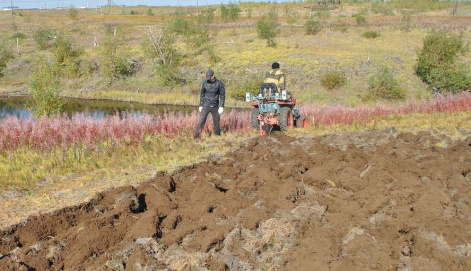New technologies will bring depleted Arctic lands back to agriculture
17 May 2021 г. Research Institute of agriculture and ecology of the Arctic

Recently, the state has been paying close attention to the industrial development of the Arctic. The increased use of minerals in this region leads to the need to minimize negative consequences for nature and to restore the vegetation and soil cover of the disturbed lands.
Scientists of the Federal Research Center "KSC SB RAS" have developed a technology for the preservation and restoration of soil fertility of the areas of the Northern Yenisei after their development. This will help to effectively use the natural potential of the Arctic agricultural landscapes, to return the depleted areas to agricultural production and to produce agricultural products of a given quantity and quality.
The developed technology includes several sequential soil restoration measures. It combines surface mechanical soil cultivation to a depth of 12-15 centimeters, use of complex mineral fertilizers and sowing of perennial grasses. These plants will provide a quick vegetation cover on the restored land, preventing soil erosion. This approach makes it possible to “program” the harvest and produce agricultural products of a given quantity and quality under the conditions of the Northern Yenisei. The technology allows one to increase the productivity of meadow crops by 2-3 times.
Scientists note that in the new methodology, much attention is paid to scientifically grounded principles of preservation and restoration of soil fertility of tundra lands and soil cultivation systems. For this, the researchers studied in detail the formation factors of crop yields in the tundra conditions and causes of soil degradation.
The advantages of the new soil cultivation technology consist in the fact that it is adapted to local conditions and takes into account possible weather changes during the growing season. The estimation of the possible circumstances affecting the crops allows you to anticipate a certain amount and quality of the crop using controllable factors of technology, mechanization, land reclamation, fertilization and plant protection.
“Our research institute has been taking care of the restored areas for three years. During this time, 120 hectares of the disturbed lands have been restored and returned to agricultural production. Now we are monitoring technogenic wastelands, following the dynamics of settlement and development of plant communities, both wild and seeded ones. With proper care, seeded meadows function for more than 10-15 years. To increase the efficiency of our technology, we plan to create and use artificial soil mixtures to replace the lost fertile soil layer during the mining operations. The use of protective belts from local shrubs on sown crop plots is also being developed; as well as tree crops are widely employed during the restoration of technologically disturbed areas, ” says Abibulla Sariev, Candidate of Agricultural Sciences, head of the biological reclamation group of the Department of Nature Management of the Scientific Research Institute of Agriculture and Ecology of the Arctic SB RAS (Norilsk).
The scientist note that the developed technology makes it possible to grow in the Arctic conditions horse grasses, fodder crops such as barley, oats and wheat, as well as leguminous fodder crops, for example, peas.
Share:
